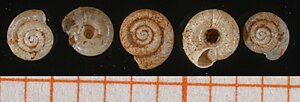Crystal snails
| Crystal snails | ||||||||||||
|---|---|---|---|---|---|---|---|---|---|---|---|---|

False pancake snail ( Hawaiia minuscula ) |
||||||||||||
| Systematics | ||||||||||||
|
||||||||||||
| Scientific name | ||||||||||||
| Pristilomatidae | ||||||||||||
| Cockerell , 1891 |
The crystal snails (Pristilomatidae, syn .: Vitreidae) are a family from the suborder of the land snails (Stylommatophora). The family is represented in Europe with around 60 species. In Central Europe there are originally six species, a seventh species was introduced.
features
The housings are usually small (max. 6 to 8 mm) and flattened, conical. In the adult stage there are 4 to 6 tightly wound, slowly increasing coils. The mouth is rounded, flattened, elliptical and cut more or less strongly by the previous turn. If the mouth is severely cut by the previous turn, it is also described as a crescent-shaped mouth. The mouth edge is straight and usually sharpened, but can also be a little thickened (then a little away from the mouth edge). The navel is completely closed or only moderately wide.
The shell is usually glass-like-colorless to light-horn-colored. On the surface there are very fine growth stripes and occasionally also very fine spiral stripes. The surface is very glossy.
The sole is not divided into the soft body. The left neck lobe is divided and has an accessory lower lobe. With a few exceptions, the genital opening is located near the base of the lower right tentacle. In the hermaphroditic genitalia, the spermatic duct is short to moderately long. An epiphallus is present and penetrates the penis laterally or apically. A blind sac (caecum or flagellum) is present or may be absent. The penile retractor muscle attaches to the blind sac or penis near the penis / epiphallus transition. The penis has an internal structure with longitudinal folds or with stimulators. The penis sheath is very small and thin or missing entirely. The spermathec develops differently with a very long or short stalk and different shape of the bladder; it can also be reduced. The perivaginal gland is always present.
Geographical distribution, habitat and way of life
The family is distributed throughout North America, Europe and West and East Asia (Russian Far East to Taiwan), and with a big question mark also on Norfolk Island in the South Pacific. The animals live in damp places in the foliage, in crevices in the rock, in the system of gaps in the ground and in caves. They mostly feed on decaying plant parts.
Taxonomy
The taxon was established in 1891 by Theodore Dru Allison Cockerell . It is now widely recognized and is placed as a family in the superfamily Gastrodontoidea Tryon, 1866. Schileyko (2003) places them as a subfamily in the family Zonitidae. Vitreidae Baker, 1930, is a more recent synonym for Pristilomatidae Cockerell, 1891. Schileyko (2003) uses this taxon on the hierarchical level of a tribe (Vitreini). According to MolluscaBase, the family is divided as follows:
- Cockerell family Pristilomatidae, 1891
- Clappiella HB Baker, 1929
- Coreovitrea Riedel, 1967
- † Eurocystina Harzhauser & Neubauer, 2018
- Gollumia Riedel, 1988
- Gyralina Andreae, 1902
-
Hawaiia Gude, 1911
- False pancake snail ( Hawaiia minuscula (Binney, 1840))
- Lindbergia Riedel, 1959
- Monadea Westerlund, 1902
- Paravitrea Pilsbry, 1898
- Ogaridiscus Chamberlin & Jones, 1929
- Paravitrea Pilsbry, 1898
- Pilsbryna HB Baker, 1929
- Genus Pristiloma Ancey, 1887 (with the subgenera Pristiloma (Pristinopsis) Baker, 1931, Pristiloma (Pricovitrea) Baker, 1931, Pristiloma (Pristiloma) and Pristiloma (Priscovitreops) Baker, 1931)
- Pycnogyra Strebel & Pfeffer, 1879
- Spinophallus Riedel, 1962
- Taurinellushka Balashov, 2014
- Troglovitrea Negrea & Riedel, 1968
-
Vitrea Fitzinger, 1833 (is divided into three sub-genera: Vitrea (Vitrea) Fitzinger, 1833, Vitrea (Subrimatus) AJ Wagner, 1907, Vitrea (Crystallus) RT Lowe, 1854)
- Widely knotted crystal snail ( Vitrea contracta (Westerlund, 1871))
- Common crystal snail ( Vitrea crystallina (OF Müller, 1774))
- Unnabeled crystal snail ( Vitrea diaphana (Studer, 1820))
- Vitrea narbonensis (Clessin, 1877)
- Narrow-forked crystal snail ( Vitrea subrimata (Reinhardt, 1871))
- Transylvanian crystal snail ( Vitrea transylvanica (Clessin, 1877))
literature
- Rosina Fechter, Gerhard Falkner: Mollusks. 287 pp., Mosaik-Verlag, Munich 1990 (Steinbach's Nature Guide 10), ISBN 3-570-03414-3
- Bernhard Hausdorf: Phylogeny of the Limacoidea sensu lato (Gastropoda: Stylommatophora) . Journal of Molluscan Studies, 64: 35-66, London 1998, ISSN 0260-1230
- Michael P. Kerney, RAD Cameron, Jürgen H. Jungbluth: The land snails of Northern and Central Europe. 384 pp., Paul Parey, Hamburg and Berlin 1983, ISBN 3-490-17918-8
Individual evidence
- ↑ Fauna Europaea
- ↑ a b Anatolij A. Schileyko: Treatise on Recent Terrestrial Pulmonate Molluscs Part 10 Ariophantidae, Ostracolethidae, Ryssotidae, Milacidae, Dyakiidae, Staffordiidae, Gastrodontidae, Zonitidae, Daudebardiidae, Parmacellidae. Ruthenica, Supplement 2 (10): 1307-1488, Moscow 2003, ISSN 0136-0027 , p. 1378.
- ↑ MolluscaBase: Pristilomatidae Cockerell, 1891